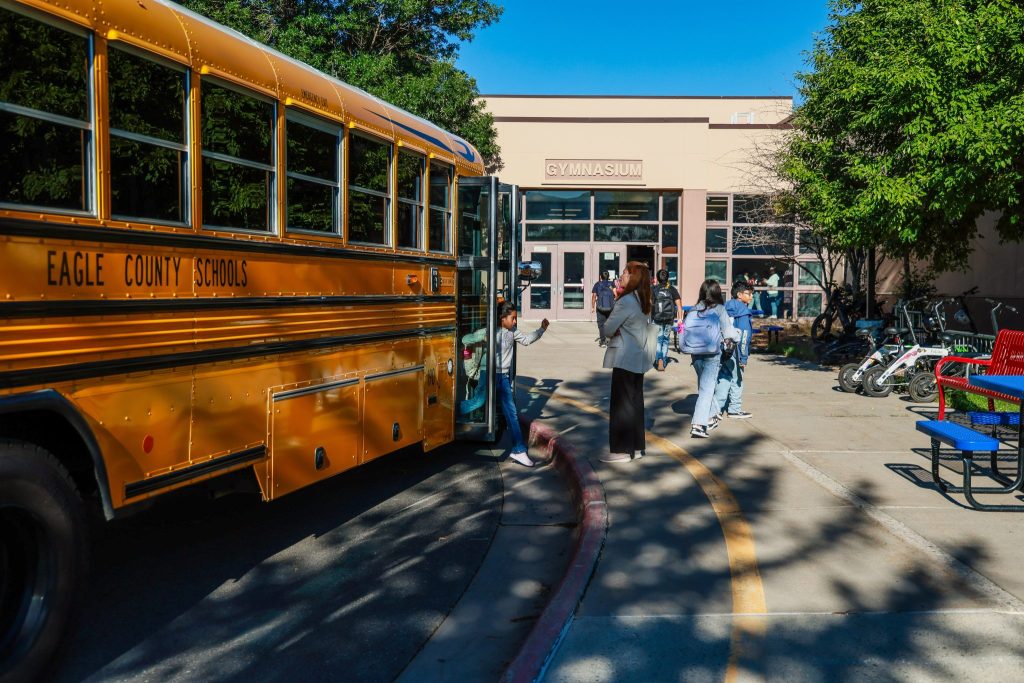‘It has meant a lot for me’: Colorado families, school districts say free school meals program is keeping kids fed, reducing stress on parents
Without more funding for the program, schools will have to start limiting access starting next year

Alexandra Sandoval/Courtesy photo
Alexandra Sandoval will never forget the look on a child’s face after he was told he didn’t have enough money to buy a meal at school.
She remembers standing with her two children in a breakfast line at their school in Rifle when a young boy was unable to purchase food. Sandoval said she offered to buy him a meal, but the boy refused.
“That just broke my heart,” Sandoval said. “To this day, I remember, and it makes me want to cry. That could be one of my kids.”
Sometimes, it was.
With a tight budget that struggled to keep up with rising grocery prices, Sandoval has had to turn to food banks to keep her family fed through the week, and affording food for school meals was always a challenge.
Her children would sometimes get food through the federal free-and-reduced school lunch program, but they had to reapply every school year, and strict income limits meant Sandoval’s family wasn’t always eligible. At times, Sandoval wouldn’t realize that money in her kids’ school accounts had run out until they told her they couldn’t get food that day.
But now, she doesn’t have to worry about that.
Under Colorado’s Healthy School Meals for All program, which state voters approved in 2022, school children have access to free breakfast and lunch regardless of their income.
Sandoval said her two youngest children,who are 16 and 11 and attended Rifle High School and Rifle Middle School, have relied on the program for their meals for the past few years.
“It has meant a lot for me,” Sandoval said.
Nearly every school district in the state participates in the program. Aspen School District is the only one that has opted out.
According to Hunger Free Colorado, roughly 100,000 more school children are eating lunches as a result of the program. But that popularity has also strained funding. Unless more revenue is approved, districts will have to limit eligibility starting in 2026.
State lawmakers this year referred twin ballot measures, Propositions MM and LL, to voters as their solution. If approved in November, the measures would raise income taxes on households earning $300,000 or more and allow the state to keep excess revenue for the program.
Proponents say passing both measures is essential to ensuring the program can continue serving all students, while also fulfilling other parts of the program that have stalled due to underfunding. Along with reimbursing districts for meals, the program is intended to increase wages for breakfast and lunch staff and provide grants to schools to purchase food from local producers.
Critics, however, say that the Healthy School Meals for All Program should exist within its means. Republican lawmakers largely voted against referring the ballot measures to voters this year, worried about higher taxes and increased government spending. A recent report from the Common Sense Institute, a Colorado think tank that promotes free economic policy, argues that neither ballot measure addresses the free meals program’s spending levels.
For school districts, the reality of not expanding the program’s funding means there will be fewer kids fed.
Districts say program benefits students, parents
School districts across the mountain region have seen a surge in students eating at school since the program took effect.
Octavio Maese, director of food and nutrition services for the Roaring Fork School District, estimates that around 50% more students are eating breakfast and 40% more are eating lunch. The district has also been able to buy better-quality foods thanks to state reimbursements under the school meals program, he said.
“It’s a moment of stability when (students) can show up to a lunchroom and choose to eat food based on their preferences, their likes, rather than a dollar amount,” said Octavio Maese, director of food and nutrition services for the Roaring Fork School District.
At Eagle County School District, the number of breakfasts served has doubled, while lunches are up 63%, according to Nutrition Director Chris DelSordo. The increase, he said, has taken some of the pressure off working parents.
“We don’t get as many of the calls from parents worried about, ‘How do I get my kids fed?'” DelSordo said. “To feed your student every day, breakfast, lunch, and dinner, is not cheap.”

For some smaller schools, the program’s future could make or break their ability to serve meals entirely.
Until recently, Steamboat Montessori, a public charter school in Steamboat Springs, didn’t have a lunch program, and students instead had to bring their own meal. But with the new state funding that was created under the Healthy School Meals for All program, the school finally had the resources to start offering its own meals.
If voters decline to approve more funding, and the school meals program shrinks its scope as a result, “It has the potential to devastate our school lunch program,” said Emily Barnhart, Steamboat Montessori’s head of school.
Barnhart said that in the two years that her school has been able to offer a free lunch program, 110 students — roughly 80% of the student body — participate daily. During that time, the school also saw major academic improvement, jumping 15 percentage points in the state’s most recent performance rating and placing in the top 99% of all districts in the state.
While Barnhart said she can’t fully attribute the improvement to free meals, she believes the program has helped students become more engaged at school.
“A well-fed child is a ready learner,” she said. “They’re just more alert, and they have energy throughout the entire day.”
Barnhart sees the impact of the program on parents, too. In a recent school survey, parents said they felt less financially stressed and had more time to engage with their children at home because they didn’t have to worry about planning and packing their meals.
“We have a lot of working families, and they’re balancing a lot of things,” Barnhart said. “Taking one thing off the plate … has just helped people become more engaged with their family, which is what kids need.”
Fighting hunger in the classroom, and beyond
Proponents for the November tax measures say the push to keep children fed comes at a critical time.
Colorado, as of 2023, recorded a 10-year high in food insecurity, and food banks across the high country are reporting more demand and fewer resources. Looming federal changes to the Supplemental Nutrition Assistance Program — including stricter eligibility requirements and less funding for states — are also expected to increase need in the coming years, anti-hunger advocates say.
Along with boosting funding for Colorado’s school meals program, the November ballot measures also allow the state to use some of that money to help offset cuts to SNAP, which are slated to take effect in 2027.
Sandoval knows the fight against hunger isn’t limited to schools. It’s why, on Saturday mornings, she volunteers for a local food bank, where she also receives provisions to help feed her family.

“There are some weeks where it will cut my grocery bill in half,” Sandoval said. “I see it in my grocery bill, but I always hear it from people, neighbors and friends that it does help a lot.”
But seeking that help isn’t always easy. Sandoval worries that if schools are forced to limit free meals to only certain students, that could lead to stigma among their peers. She thinks back to the child who declined her help after she offered to buy him a meal.
“There’s a lot of stigma with trying to get assistance,” Sandoval said.
Aspen airport sees more delays, cancellations in wake of new wind-reporting policy
A change from instantaneous wind-speed reporting to average wind-speed reporting aligned with a higher rate of flight delays, diversions, and cancellations this summer at the Aspen/Pitkin County Airport.










